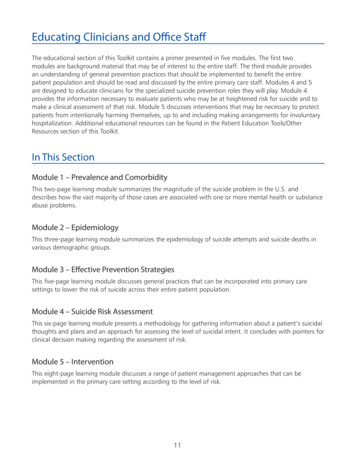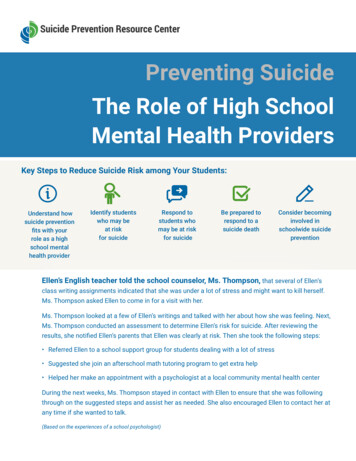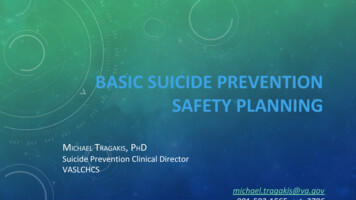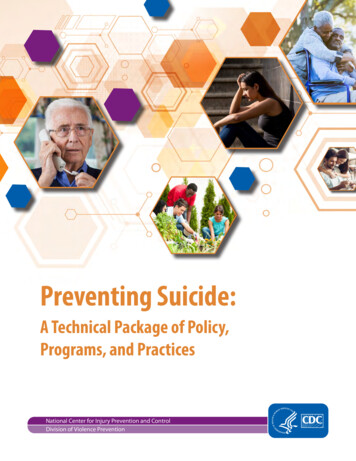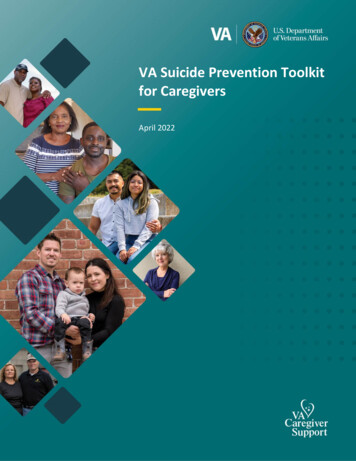
Transcription
VA Suicide Prevention Toolkit for CaregiversVA Suicide Prevention Toolkitfor CaregiversApril 20221
VA Suicide Prevention Toolkit for CaregiversSupport for Veterans. Support for You.Dear Caregiver,The U.S. Department of Veterans Affairs (VA) understands that caregivers are our partners in providingcare to our nation’s Veterans. We also know that it can be challenging to manage both the care of aVeteran and the everyday responsibilities of work and family. We are grateful for the role you play, andwe are here to support you.We recognize that you are the hidden heroes at home, guiding our nation’s Veterans through theirjourneys to healthy, fulfilling lives and helping them cope with both visible and invisible injuries. Invisibleinjuries, such as posttraumatic stress disorder and traumatic brain injury, can cause emotional distress,feelings of loneliness, and thoughts of suicide. These injuries may also be harder to recognize thanvisible injuries. As a caregiver to a Veteran, you may be the first to notice the signs of these invisibleinjuries. You may also be the first to notice any problems with alcohol or substance use.The VA Suicide Prevention Toolkit for Caregivers includes important information about suicideprevention, as well as evidence-based mental health and substance use disorder treatments that canhelp Veterans recover and meet their goals. This toolkit also offers resources that anyone can access inthe event of a crisis. Please visit sp nt.asp to read more about evidence-basedtreatments.We also want to help you take care of yourself. Though you may be focused on caring for a Veteran,your own well-being is equally important. This toolkit equips you with information on self-care so thatyou can obtain additional support when you need it—helping you remain healthy and strong as youprovide care.The responsibility of caring for a Veteran does not have to be yours alone. The VA Caregiver SupportProgram provides support and services, including skill-building courses, peer mentoring, coaching, andother resources. A Caregiver Support Program team is available at every VA medical center throughoutthe nation to provide support to you in your role.Mental health, treatment of substance use disorders, and suicide prevention are top priorities at VA.Ensuring that you have the resources you need to help the Veterans in your care while maintaining yourown well-being is important to us.We thank you for all you do every day, and we hope that these resources are helpful to you and theVeteran in your care.Sincerely,Matthew A. Miller, Ph.D., M.P.H.Director, Suicide PreventionVA Office of Mental Health andSuicide PreventionColleen Richardson, Psy.D.Executive Director, Caregiver Support ProgramPatient Care Services2
VA Suicide Prevention Toolkit for CaregiversThe VA Suicide Prevention Toolkit for Caregivers provides caregivers withinformation about suicide prevention, mental health, and substance usedisorder treatment, as well as self-care resources. It also lists resources forVeterans and military families.Table of ContentsSupport for Veterans. Support for You. .2Information for Caregivers About Veteran Suicide .4Our Approach to Suicide Prevention . 4Role of Caregivers in Suicide Prevention . 4Risk Factors and Protective Factors . 6How Caregivers Can Support Veterans. 7Peer Support .11Social Media Support .11Chaplain Support .12Valuable Self-Care Information for Caregivers . 13VA Caregiver Support Program .13Program of Comprehensive Assistance for Family Caregivers .13Program of General Caregiver Support Services .13Maintaining Mental Wellness .14Additional Resources .15Financial Support Services .15VA Mobile Apps .15Respite .16Respite Care at VA . 16Resources for Veterans and Their Caregivers and Families . 18Appendix . 263
VA Suicide Prevention Toolkit for CaregiversInformation for Caregivers About Veteran SuicideSuicide prevention is VA’s top clinical priority. Every death by suicide is a tragedy, and wewill not relent in our efforts to connect Veterans who are experiencing an emotional ormental health crisis with lifesaving support. But VA realizes that no one organization, agency, or personcan adequately support suicide prevention by itself. By involving Veterans’ family members, peers, andcommunities, we can work together to reach Veterans before a crisis occurs.VA knows that a caregiver to a Veteran is a keen observer of the Veteran’s physical and mental health,and often a trusted confidant. That’s why we want caregivers to have key information about suicideprevention, the warning signs for suicide risk, and where to get help when it is needed.Our Approach to Suicide PreventionVA’s comprehensive approach to suicide prevention considers the many factors that contribute to riskfor suicide and looks beyond the individual—to family members, caregivers, peers, and communities—for support in preventing it. We use the latest available research to develop evidence-based,multidisciplinary approaches to promote health, prevent disease, and help people lead longer lives.Evidence-based mental health and substance use disorder treatments focus on helpingVeterans recover and meet their goals. To read more about these treatments, dex.asp and asp.VA’s comprehensive approach is grounded in four key areas: Preventing suicidal behavior.Offering whole health care, which considers the patient’s care preferences, as well as factorsbeyond mental health, including physical health, spiritual health, alcohol or substance useservices, and life events.Using data and research to tailor approaches to specific Veteran populations.Collaborating with diverse communities to empower their members to participate in suicideprevention efforts.Role of Caregivers in Suicide PreventionCaregivers play an important role in a Veteran’s life—sometimes a lifesaving one. Whether you’re thespouse, another family member, or a friend of a Veteran, you may be the first to recognize changes inmood and behavior, such as expressions of anger or emotional pain or increasing use of alcohol ordrugs.No matter your relationship with the Veteran, as a caregiver, you have a vital role in supporting theVeteran and preventing a crisis. Here are some steps that can help:4
VA Suicide Prevention Toolkit for Caregivers Learn about risk factors and how to recognize suicideTake the VA S.A.V.E. Training Coursewarning signs.Watch the VA S.A.V.E. training video, which isThis free, online VA S.A.V.E. Training videodesigned to enable anyone to demonstrate care,was designed in partnership withsupport, and compassion when talking with aPsychArmor Institute to help viewers learnVeteran who could be at risk for suicide. (See thehow to identify when a Veteran may be attext box to the right for more information.)risk for suicide and to empower them toAttend medical appointments with the Veteran. Talkplay a vital role in suicide prevention.with their health care team to better understandVisit www.psycharmor.org/courses/s-a-v-e.their care needs and advocate to be involved in theircare.Encourage the Veteran to pursue mental healthtreatment, including treatment of substance use disorders and—in this and other ways—helpreduce the stigma they may associate with seeking treatment.Support adherence to medication and to treatment plans.Participate in the Veteran’s safety planning. Be familiar with the Veteran’s safety plans so thatyou can reinforce coping strategies.Discuss access to lethal means. Lethal means are objects like guns, medications, alcohol, opioidsor other substances, ropes, cords, or sharp objects that can be used during a suicidal crisis.Better storage practices of potentially harmful things can help make the home safe and savelives. Thoughts about suicide are often short-lived. A safe home environment can buy you, ora person you’re concerned about, time to get help. Safely storing things that can beused to harm oneself, such as firearms and medications, or removing them from yourhome—even temporarily—can save lives. To learn more about safe home environments and Lethal Means Safety, visit:www.keepitsecure.net.Help support the Veteran’s sense of connectedness in the community, increasing social supportand a sense of belonging.Caregivers Are Our Partners in CareCaregivers are advocates and partners in the care of the Veteran. Maintaining communication withother members of the health care team is an important part of providing the Veteran the best carepossible. Attend appointments Ask questions Track medications Make lists and schedules5
VA Suicide Prevention Toolkit for CaregiversRisk Factors and Protective FactorsKnowing about risk factors—and protective factors—is key to providing Veterans with support andpreventing a crisis.Veterans and non-Veteran adults share many important risk factors and protective factors when itcomes to suicide. Risk factors are characteristics associated with an increased likelihood of suicidal behaviors. Riskfactors for suicide include prior suicide attempts (the period immediately following a suicideattempt is one of high risk); certain mental health conditions or substance use disorders; accessto lethal means, such as firearms or certain medications; and stressful life events, such asdivorce, job loss, or the death of a loved one. For more information and support for familymembers coping with suicidality, read VA’s resource guide: embers.pdf.Protective factors can help offset risk factors. These are characteristics associated with adecreased likelihood of suicidal behaviors. Factors that protect against suicide risk includeaccess to mental health care, access to care for substance use disorders, feeling connected toothers, adaptive spiritual functioning, and positive coping skills.Veterans also have unique characteristics and experiences related to their military service that mayincrease their suicide risk or protect them against it: Veteran risk factors include transition-related challenges, posttraumatic stress disorder,traumatic brain injury, and experience with firearms. Veteran protective factors include resilience, a sense of belongingAre you a Veteran in crisis orand purpose through military service, access to VA mental healthconcerned about one?care and care for substance use disorders, and positive coping skillslearned in high-stress settings.Call 1-800-273-8255 and Press1, text to 838255, or chatTo prevent Veteran suicide, we must work together to increase protectiveonline atfactors while decreasing risk factors in communities across the nation.VeteransCrisisLine.net/Chat.Warning SignsRecognizing the warning signs for suicide risk and knowing how to respondto them are important. Ensure that you know how to recognize thesewarning signs: Hopelessness; feeling like there’s no way outAnxiety, agitation, sleeplessness, or mood swingsFeeling like there is no reason to liveRage or angerEngaging in risky activities without thinkingIncreasing alcohol or drug useWithdrawing from family members and friendsCall 911 for emergencyassistance.Go to the nearest emergencyroom.Find the VA resources nearestto you ces.6
VA Suicide Prevention Toolkit for CaregiversThe presence of the following signs requires immediate attention: Thinking about hurting or killing oneselfLooking for ways to kill oneselfTalking about death, dying, or suicideSelf-destructive behavior, such as problems with alcohol or drug use or carelessly handlingweaponsHow Caregivers Can Support VeteransFrom managing a household to health care visits, to providing emotional support or hands-on care, acaregiver’s list of responsibilities may seem endless. However, taking a few extra steps with the Veteranyou care for can be critical in preventing a crisis or keeping a crisis from escalating.Create a Safety PlanVeterans who are at risk for suicide or who have survived a suicide attempt should have a safety plan inplace. As a caregiver, you can help the Veteran you care for create this plan. Working with the Veteranon a safety plan can help avert or mitigate crises, providing the Veteran with a list of coping strategies,sources of support, and resources they can turn to in times of distress.The safety plan should be brief, easy to read, and written in the Veteran’s own words. Safety plansshould be easily accessible to the Veteran and select family members, friends, and caregivers at alltimes.A safety plan should include six steps:1. Recognizing warning signs: “These are my warning signs that things are starting to feel out ofcontrol.”2. Using internal coping strategies: “When I notice these warning signs, these are things that I cando on my own to help make sure I do not act on my suicidal thoughts or urges.” Take a walk or engage in some other form of exercise. Develop a healthy hobby, such as dancing. Journal your thoughts and feelings. Relax with meditation or yoga. Find peaceful focus through spirituality and prayer.3. People and social settings that provide distraction: “When my initial coping strategies do notfully resolve the situation, I will reach out to others.” Go to the gym. Visit a coffee shop. Take a walk in the park. Check on a friend or neighbor.4. People whom I can ask for help if distraction alone doesn’t fully work: “When I need to talkabout how I’m feeling, I will contact the people in my life who care about me, are supportive,and want to help.” Call a trusted friend or family member.7
VA Suicide Prevention Toolkit for Caregivers Speak with a spiritual or religious adviser (priest, pastor, rabbi, imam).5. Professionals or agencies I can contact during a crisis: “When I need to talk to a mental healthprofessional or other provider, I will call one.” Call a therapist. Call the Veterans Crisis Line (1-800-273-8255 and Press 1). Call a doctor’s office.6. Making the environment safe: “To help keep myself safe, I will remove or safely store things Icould use to hurt myself.” Check the environment for unused medications that can be recycled or secured. Secure firearms separate from ammunition. Give potentially self-harming object(s) to a trusted adult for safekeeping. Remove alcohol or other substances that may pose a risk. Post a completed safety plan where it is easy to find and share it with trusted family,friends, or neighbors.VA’s safety plan template and more information are available online net/media/1048/safety-plan-template.pdf. You canalso use the template in the appendix.To see how to create a safety plan, teranSuicideIsEveryonesBusiness.pdf.To learn more about the importance of creating a safety plan that is tailored to individual or familyneeds and can support Veterans and loved ones in the home who may be in crisis, download VA’s“Fierce Loyalty” video at y.Practice Safe Firearm StorageIf you or the Veteran you care for owns a firearm, discussing ways to safely store firearms may helpprevent a crisis or accidents in the home.VA respects the important role firearms play in many Veterans’ lives and is dedicated to educatingVeterans and their families about safely storing firearms when not in use, in a way that is consistent witheach Veteran’s values and priorities. Practicing safe firearm storage is important for creating saferhomes and preventing suicide.Safely storing firearms when not in use (i.e., storing them locked and unloaded) puts time and spacebetween an individual in distress and a firearm. Increasing the time and distance between someone in asuicidal crisis and access to lethal means can reduce suicide risk and save lives. While some suicidalcrises last a long time, most last minutes to hours, and a safely stored firearm can buy you, or the personyou’re concerned about, time to get professional help.It’s a myth that somebody who really wants to die by suicide will find a way to do so. People who aresuicidal generally do not seek other ways to attempt suicide if they do not have immediate access to themethod they planned to use or if safeguards make using that method more difficult. For example, if8
VA Suicide Prevention Toolkit for Caregiverssomeone in crisis plans to use a firearm to attempt suicide, they are not likely to try to use othermethods if their firearm is safely stored or removed from the home.Safe firearm storage practices involve using cable or trigger locks and making sure firearms are unloadedand secured when not in use, with ammunition stored separately. More information about firearmstorage options can be found at the Project ChildSafe website of the National Shooting SportsFoundation: www.projectchildsafe.org/.Veterans and their families, caregivers,and loved ones can also request a gunlock from any VA suicide preventioncoordinator (SPC) (find your local SPC es). In addition, theNational Shooting Sports Foundationwebsite (www.nssf.org/safety) can helpyou learn more about effective ways tosafely secure firearms and find storageoptions that work best for you and yourfamily.Key Points for Talking About Firearm SafetyThe best way to find out if a Veteran you’re concerned abouthas access to firearms is to ask. If the Veteran has access to afirearm, suggest they take the following steps to keepthemselves and their family safe: Keep guns locked and unloaded when not in use so theycannot be accessed by children and unauthorized adults.Store ammunition separately from firearms and out of thereach of children and unauthorized adults.Regularly reassess steps to ensure safe storage and use offirearms, especially during periods of increased stress oremotional crisis.Request a gunlock from your local VA suicide preventioncoordinator (SPC). Find your SPC using the VA ResourceLocator.It’s never easy to discuss suicide, but itcould save a life. Starting the conversation about safely handling andstoring firearms could save a Veteran’slife. Here are some key talking points tohelp you get fety/.Safely Store and Dispose of MedicationsTaking medications is part of a healthy life for some Veterans and their family members, butmedications should be safely and securely stored when they are not in use. Caregivers can preventintentional or unintentional overdoses by managing the Veteran’s medication dosages and safelydisposing of unused or expired medications.VA facilities can provide safe means of medication disposal. More information can be found vacenterformedicationsafetyprescriptionsafety.asp. All VA pharmacies have receptacles for medication disposal. To find a location, earch/spring/main?execution e2s1.Caregivers should ask a doctor or pharmacist about other options for safely storing medications ordisposing of unused medications.9
VA Suicide Prevention Toolkit for CaregiversNaloxone Use for Opioid-Related OverdosesThe use of opioids, prescribed or not, comes with significant risks. In the U.S., opioid overdose remains aleading cause of accidental death and accounts for more than half of all overdose deaths, according to thelatest statistics from the National Institute on Drug Abuse. People who use recreational drugs—includingcocaine and methamphetamine—also face an increased risk for opioid overdose. Recreational drugs may becontaminated with unknown amounts of potentially deadly opioids, such as fentanyl.Naloxone can be lifesaving during an opioid overdose, but most people don’t know what naloxone is or howto use it. Learn more about naloxone—which, for VA patients who need it, is available from VA for FREE—andhow it can save a Veteran’s life. Naloxone is a first-line defense against opioid overdoses. If there are opioidsin your home or a loved one uses recreational drugs, keeping naloxone on hand can help save a life.Free to any Veteran who needs it and is enrolled in VA, naloxone is a medication designed to rapidly reversean opioid overdose. It can be administered as a nasal spray or an injection. Naloxone is safe to use and willhave an effect only on someone who is overdosing. When used immediately after an overdose, naloxone canblock the effects of opioids and help prevent death. Naloxone can temporarily restore breathing, allowingtime for medical help to arrive. Its effects are only temporary, so it is critical to seek medical assistanceimmediately after giving naloxone. Veterans who are enrolled in VA health care and need naloxone canreceive it at no cost.VA has documented more than 2,300 successful opioid overdose reversals with naloxone. To learn moreabout opioid overdose and how naloxone can save the life of your loved one, /overdose.asp.Encourage Substance Use Disorder TreatmentSubstance use disorders (SUD) can have a major impact on the lives of Veterans and their families. Whilethese conditions are relatively common, many people are not aware that they are associated withincreased suicide risk. There are effective, evidence-based treatments that reduce the risk of suicide andpremature death from all causes, including those related to SUD disorders. Effective SUD treatmentsavailable through VA include brief counseling; other behavioral treatment approaches; and medicationsfor alcohol, tobacco, and opioid use disorders. Caregivers can provide information about theeffectiveness of SUD treatment and encourage engagement in treatment. Information on substance usedisorder treatments can be found at asp.VA SUD treatment is tailored to individual needs and preferences, including assessment and treatmentof common co-occurring conditions, such as PTSD and depression. Caregivers can find locations for VAsubstance use disorder treatment at: www.va.gov/directory/guide/sud.asp.VA also has specific resources (e.g., quit line, texts) to support Veterans during tobacco quit attempts at:https://veterans.smokefree.gov/.10
VA Suicide Prevention Toolkit for CaregiversAssist in Pain ManagementPain can affect sleep, mood, stress levels, and level of activity. Living with chronic pain can also increasethe risk for suicide. Caregivers of Veterans experiencing pain can help the Veteran manage the pain andits related effects. Please visit www.va.gov/PAINMANAGEMENT/Veteran Public/index.asp for tools,resources, and information on how to manage pain.Caregivers can find additional information about pain management and resources for complementarytherapies, such as cognitive behavioral therapy, acceptance and commitment therapy, and physicaltherapy at www.va.gov/PAINMANAGEMENT/Veteran Public/Complementary Treatments.asp.Access Communities of SupportCaregivers help Veterans develop a support system and a sense of connection with their communitythat reinforces safety and comfort by letting Veterans know that someone is there for them. Researchshows that Veterans with a strong support system tend to have more positive mental health outcomes,including lower rates of suicidal ideation. 1 Communities of support—whether these are in person (e.g.,families, friends, and neighbors) or virtual (e.g., online or social media networks)—are critical to one’smental well-being.Peer SupportDuring military service, many Veterans had built-in social support and developed unit cohesion,along with a sense of belonging, purpose, and connection. When a Veteran is back home, it maybe challenging to find peers who understand their background, military experiences, and how toreintegrate into the civilian community. Caregivers will be among the first to notice Veteranswho are missing their peers and can help connect them with peer support.One source of this support is the peer specialists at VA who work closely with clinical staff,including suicide prevention coordinators, to provide direct support to Veterans. As Veteransthemselves, peer specialists can help Veterans identify their own skills and strengths. They mayalso help the Veteran feel more comfortable talking about topics related to their militaryexperience. Learn more at tal-health/.Social Media SupportIn this digital age, it’s common to find sources of support online, especially through mobile appsand social media. Caregivers are often connected with Veterans in online communities and canprovide and promote additional support and connectedness for Veterans through technology.That’s why VA has collaborated with technology , Objective Zero Foundation (www.objectivezero.org), Code of Support1Adams, R. E., Urosevich, T. G., Hoffman, S. N., et al. 2017. Social support, help-seeking, and mental health outcomes amongveterans in non-VA facilities: results from the Veterans' Health Study. Military Behavioral Health 5, no. 4:393–405.11
VA Suicide Prevention Toolkit for CaregiversFoundation (www.codeofsupport.org), and RallyPoint (www.rallypoint.com)—that share ourcommitment to preventing Veteran suicide. These organizations are working with VA topromote social connectedness and expand the reach of lifesaving resources through mobileapps and online platforms. Caregivers can use these technologies to stay connected to theVeterans in their lives and to connect with other caregivers and military families. These socialmedia platforms or apps are easy to use and are available at your fingertips. Learn more aboutsocial media safety with VA’s toolkit athttp://www.mentalhealth.va.gov/suicide edia-Toolkit-1-8 508.pdfFind additional information on these VA partners in the resources section at the end of thistoolkit.Chaplain SupportIn times of stress, turning to religious or spiritual care may help alleviate emotional distress,provide hope, strengthen faith or spiritual connections, and provide social interaction andsupport. Daily spiritual practices and engagement in a church or other type of faith-basedcommunity have been reported to be generally protective against suicide.VA chaplains are available as a resource, refuge, or referral point for Veterans and their familiesand caregivers.Whether you or the Veteran you care for belongs to a faith community, practices meditation, orsimply wishes to seek guidance, VA chaplains provide support and care and can connect youwith resources within VA or in the community, including connection to a local spiritualcommunity.VA chaplains serve in a variety of roles, including as a member of the Veteran’s clinical careteam. They can assist you with decision-making and communication between the Veteran, youas the caregiver, and health care providers. VA chaplains can also mediate conflicts betweenVeteran patients, their families, and VA staff members.In addition, VA chaplains can help interpret multifaith and multicultural traditions and leadobservances, worship, prayers, blessings, and more. For more information, please contact yourlocal VA medical center and request to be connected to Chaplain Services.To help the Veteran you care for access support and connection outside the home, see theinformation about VA’s programs in the resources section at the end of this toolkit.12
VA Suicide Prevention Toolkit for CaregiversValuable Self-Care Informatio
But VA realizes that no one organization, agency, or person can adequately support suicide prevention by itself. y involving Veterans' family members, peers, and communities, we can work together to reach Veterans before a crisis occurs. VA knows that a caregiver to a Veteran is a keen observer of the Veteran's physical and mental health,
